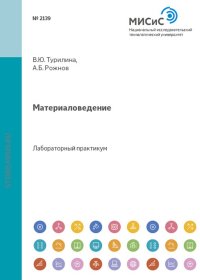Материаловедение
Покупка
Тематика:
Материаловедение
Издательство:
Издательский Дом НИТУ «МИСиС»
Под ред.:
Никулин Сергей Анатольевич
Год издания: 2013
Кол-во страниц: 51
Дополнительно
Лабораторный практикум содержит 5 работ к общим и специальным курсам металловедения и термической обработки. Цель практикума - привить студентам навыки распознавания макро- и микроструктуры сталей и сплавов, определения их характеристик. В пособии дается описание методов определения характеристик и обработки результатов эксперимента, а также домашнее задание и контрольные вопросы для проверки усвоения материала изучаемого курса. Пособие предназначено для бакалавров и магистров, обучающихся по направлениям 150100 «Материаловедение и технологии материалов», 150400 «Металлургия», 011200 «Физика».
Тематика:
ББК:
УДК:
ОКСО:
- ВО - Бакалавриат
- 22.03.01: Материаловедение и технологии материалов
- 22.03.02: Металлургия
ГРНТИ:
Скопировать запись
Фрагмент текстового слоя документа размещен для индексирующих роботов
МИНИСТЕРСТВО ОБРАЗОВАНИЯ И НАУКИ РФ ФЕДЕРАЛЬНОЕ ГОСУДАРСТВЕННОЕ АВТОНОМНОЕ ОБРАЗОВАТЕЛЬНОЕ УЧРЕЖДЕНИЕ ВЫСШЕГО ПРОФЕССИОНАЛЬНОГО ОБРАЗОВАНИЯ «НАЦИОНАЛЬНЫЙ ИССЛЕДОВАТЕЛЬСКИЙ ТЕХНОЛОГИЧЕСКИЙ УНИВЕРСИТЕТ «МИСиС» № 2139 Кафедра металловедения и физики прочности В.Ю. Турилина А.Б. Рожнов Материаловедение Лабораторный практикум Под редакцией профессора С.А. Никулина Допущено учебно-методическим объединением по образованию в области металлургии в качестве учебного пособия для студентов высших учебных заведений, обучающихся по направлению Металлургия Москва 2013
УДК 669.017 Т86 Р е ц е н з е н т д-р техн. наук, проф. С.В. Добаткин (ИМЕТ им. А.А. Байкова РАН) Турилина, В.Ю. Т86 Материаловедение : лаб. практикум / В.Ю. Турилина, А.Б. Рожнов; под ред. С.А. Никулина. – М. : Изд. Дом МИСиС, 2013. – 51 с. Лабораторный практикум содержит 5 работ к общим и специальным курсам металловедения и термической обработки. Цель практикума – привить студентам навыки распознавания макро- и микроструктуры сталей и сплавов, определения их характеристик. В пособии дается описание методов определения характеристик и обработки результатов эксперимента, а также домашнее задание и контрольные вопросы для проверки усвоения материала изучаемого курса. Пособие предназначено для бакалавров и магистров, обучающихся по направлениям 150100 «Материаловедение и технологии материалов», 150400 «Металлургия», 011200 «Физика». © В.Ю. Турилина, А.Б. Рожнов, 2013
THE MINISTRY OF EDUCATION AND SCIENCE OF THE RUSSIAN FEDERATION NATIONAL UNIVERSITY OF SCIENCE AND TECHNOLOGY “MISiS” Department of Physical Metallurgy and the Physics of Strength V.Yu. Turilina A.B. Rojnov Metal Science Laboratory manual Edited by professor S.A. Nikulin Moscow 2013 MISiS PUBLISHING HOUSE
R e v i e w e r Dr. Sc., Professor S.V. Dobatkin (IMET RAN) Turilina, V.Yu. Metal science : laboratory manual / V.Yu. Turilina, A.B. Rojnov; edited S.A. Nikulin. – М. : Publishing House "MISiS", 2013. – 51 p. Laboratory manual has 5 labs for further study of the general and special courses on metal science and heat treatment. The purpose of the laboratory manual – to teach students to recognize the macro- and microstructure of steels and alloys, to determine their main characteristics. In the laboratory manual are described the methods for determining the characteristics of steels and alloys and processing of the experimental results, as well as home work and test questions to self-verification. The manual is intended for undergraduate and graduate students in areas of 150100 "Materials Science and Technology of Materials", 150400 "Metallurgy", 011200 "Physics".
CONTENTS 1 General introduction 6 2 Laboratory works 10 Laboratory work N 1 The structure of annealed carbon steels 10 Laboratory work N 2 Effect of heat treatment on the microstructure and hardness of cold-worked steels 16 Laboratory work N 3 Effect of heat treatment on the microstructure and properties of overheated steels 21 Laboratory work N 4 Effect of heat treatment on mechanical properties of structural steels 26 Laboratory work N 5 Effect of heat treatment on the microstructure and hardness of tool steels 36 3 Home work 44 4 Control tests 47 References 50
1 GENERAL INTRODUCTION Today steels and alloys remain the basic materials in all areas of modern engineering. Therefore each expert which work is connected with use of metal materials, anyhow have to decide a problem of a choice of an optimum material and technology of its processing for spesific products. Materials are evolving today faster than at any time in history. Industrial nations regard the development of new and improved materials as an “underpinning technology” – one which can stimulate innovation in all branches of engineering, making possible new designs for structures, appliances, engines, electrical and electronic devices, processing and energy conservation equipment, and much more. Many of these nations have promoted government-backed initiatives to facilitate the development and exploitation of new materials: their lists generally include “high-performance” composites, new engineering ceramics, high-strength polymers, glassy metals, and new high-temperature alloys for gas turbines. These initiatives are now being felt throughout engineering, and have already stimulated design of a new and innovative range of consumer products. So the engineer must be more aware of materials and their potential than ever before. Innovation, often, takes the form of replacing a component made of one material (a metal, say) with one made of another (a polymer, perhaps), and then redesigning the product to exploit, to the maximum, the potential offered by the change. The engineer must compare and weigh the properties of competing materials with precision: the balance, often, is a delicate one. It involves an understanding of the basic properties of materials; of how these are controlled in processing; of how materials are formed, joined and finished; and of the chain of reasoning that leads to a successful choice. Goal of this course is to provide this understanding. Such choice is impossible to make without knowledge of interrelations of a chemical composition, structure and properties of materials, and also the basic ways of the heat treatment, allowing to provide the required structure and properties of a materials. It is necessary to understand also how and in which conditions those or other machinery parts or designs are used, what requirements in terms of mechanical and other properties, reliability and safety at operation they have to meet. The discipline “Materials science” is one of the major components of masters training in a training direction of “Advance material science and Engeneering”. A discipline’s orientation is both theoretical and practical.


